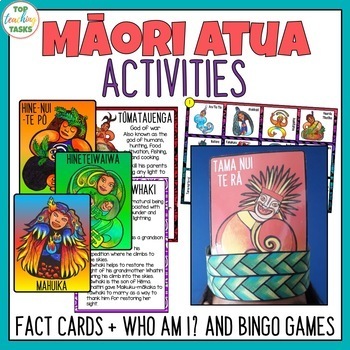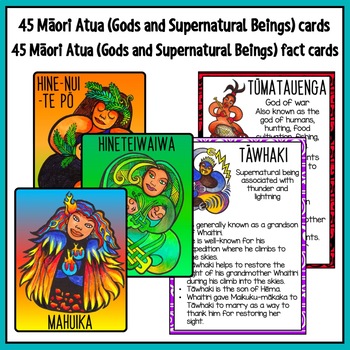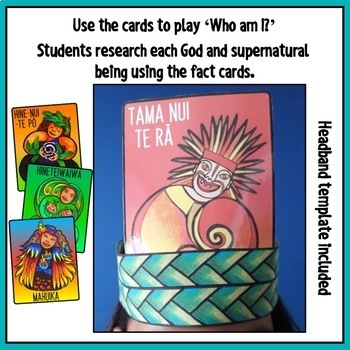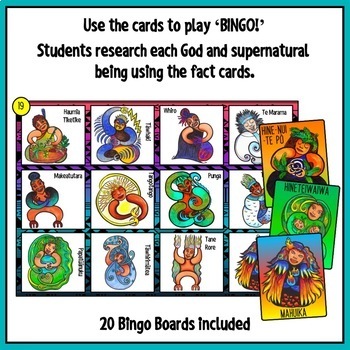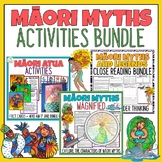Māori Gods and Supernatural Beings Activities | Maori Language Week
- Zip
What educators are saying
Also included in
- Explore Maori Myths and Legends (Pūrākau) and the mythical world of Māori Gods and Supernatural Beings with our engaging activities. Your students will be engrossed while learning with our Who am I? and Bingo games and be challenged to think outside the square with our higher order thinking activitiPrice $18.99Original Price $32.00Save $13.01
Description
Explore Maori Myths and Legends and the mythical world of Māori Gods and Supernatural Beings with our engaging activities. Integrate the Maori culture into your reading program with our information cards, and use your students' new knowledge to play two fun games! These are a great way to retain their new learning.
If you are looking for this resource with a digital option, click here.
This resource features British spelling and A4 paper size.
In this pack you will receive:
1. 45 Māori Atua Display Cards
2. 45 Māori Atua Fact Cards
3. A headband template and instructions to play "Who Am I?"
4. 20 Bingo Boards and instructions to play Bingo.
Māori Gods and Supernatural Beings included:
- Aratiotio
- Ārohirohi
- Auahitūroa
- Haumia Tiketike
- Hine-Nui-Te-Pō
- Hinemoana
- Hineraukatauri
- Hineteiwaiwa
- Ika Roa
- Ikatere
- Io Matea Kore
- Kahukura
- Kiwa
- Kōhatu Tipua
- Kūī
- Mahuika
- Makeatutara
- Maru x 2
- Māui
- Papatūānuku
- Pūhaorangi
- Punga
- Rākau Tipua
- Ranginui
- Rehua
- Rohe
- Rongo Mā Tāne
- Ruaumoko
- Tama-Nui-Te-Rā
- Tāne Mahuta
- Tāne-rore
- Tangaroa
- Tangotango
- Tāwhaki
- Tāwhirimātea
- Te Marama
- Tinirau
- Tū-Te-Wehi-Wehi
- Tūmatauenga
- Uenuku x 2
- Urutengangana
- Whaitiri
- Whio
✫✫✫✫✫✫✫✫✫✫✫✫✫✫✫✫✫✫✫✫✫✫✫✫✫✫✫✫✫✫✫✫✫✫✫✫✫✫✫✫✫✫✫✫✫✫✫✫✫✫✫✫✫✫✫✫✫✫✫✫
You May Also Like:
- Close Up MEGA BUNDLE - Close Reading Comprehension/Higher Order Thinking
- Close Up BIG BUNDLE - Close Reading Comprehension Texts / Higher Order Thinking
Find our full range of reading comprehension resources (featuring US AND British Spellings) here!
✫✫✫✫✫✫✫✫✫✫✫✫✫✫✫✫✫✫✫✫✫✫✫✫✫✫✫✫✫✫✫✫✫✫✫✫✫✫✫✫✫✫✫✫✫✫✫✫✫✫✫✫✫✫✫✫✫✫✫✫
We really appreciate your feedback! Leaving feedback earns you TPT credits!
If you're interested in upcoming Top Teaching Tasks resources, click here to FOLLOW us.
✫✫✫✫✫✫✫✫✫✫✫✫✫✫✫✫✫✫✫✫✫✫✫✫✫✫✫✫✫✫✫✫✫✫✫✫✫✫✫✫✫✫✫✫✫✫✫✫✫✫✫✫✫✫✫✫✫✫✫✫
Stay in touch:

